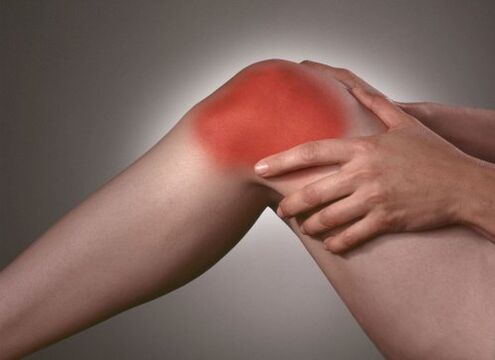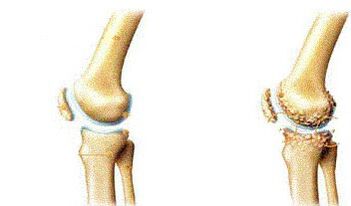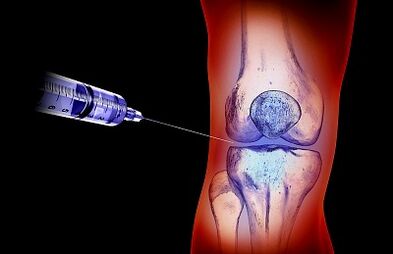
The knee, like other joints, consists of bones and cartilage.Cartoon is a smooth, elastic and elastic layer that guarantees the lightness of the aisle and the lack of friction.Damage of the cartilage by chronic wear is calledOsteoarthritis of the knee joint.
There are many factors that lead to osteoarthritis of the knee joint:
- genetic predisposition;
- Obesity;
- Abnormal movement;
- Injuries.
One person has no pain for a long time, and if the osteoarthritis of the knee leads to expansion shape, the first symptoms occur.The patient consults a doctor, but the treatment of an advanced disease can already be successful.
Osteoarthritis of the knee joint is often a result of accidents and injuries, but can only manifest itself after a few years.Therefore, with the slightest suspicion of this disease, you should consult a doctor.
Symptoms of the arthrosis of the knee joint
The symptoms of arthrosis of the knee joint include:

- Pain increases during activity;
- Swelling;
- Increase the skin temperature;
- Acceptance of the mobility of the knee joint;
- The creaking, the crispy sound that can be heard during the movement.
Pain after periods of inactivity is one of the most common symptoms of knee osteoarthritis.It expresses herself in the morning when the joints need time to warm up in the right way.After a person is like a while, the pain drops.
Sometimes you can notice the first signs of knee arthrosis by just looking at it.Even if the knee protrudes more than usual, this can be the first sign.The increased kneeling tendency to swell is easy to see.The finger thickness of the fingering forms above the knee chal because this place is the weakest.This is due to an increase in the accumulation of liquid in the joint.
The reduction of flexibility in the legs can indicate osteoarthritis of the knee joint.Those who used to touch the heels of the buttocks that stood on one leg, but can go half as far today should consult a doctor.Due to the knee osteoarthritis that gets shorter, thigh muscles can work and violate more difficult than before.These muscles have to be stretched and strengthened to restore previous functions.
Another sign of the osteoarthritis of the knee joint is the decrease in muscle resistance in the legs.
Arthrosis turns cartilage that is like glass into a rough fabric that looks like sandpaper in the early stages.If these surfaces rub each other, you can hear the creak and the friction noise in the joint.
How is osteoarthritis of the knee diagnosed?

The diagnosis of arthrosis of the knee begins with a medical examination of a doctor.Before taking, determine which pain arises to make the doctor the correct diagnosis.Also find out whether someone has arthritis in your family.
Your doctor can prescribe additional diagnosis, including:
- The magnetic resonance imaging (MRI) scans X -rays that can show bones and cartilage damage as well as the presence of bone spores;
- MRI can be ordered if X -rays do not result in a clear cause of joint pain or if the X -rays show that other types of joint tissue can be damaged.Doctors can use blood tests to exclude other diseases that can cause pain, such as:B. rheumatoid arthritis, another type of arthritis caused by impaired immune system.
How is osteoarthritis of the knee joint treated?
The main tasks in the treatment of osteoarthritis of the knee joint are pain relief and the return of mobility.
Treatment planAs a rule, contains a combination of the following actions:
- Weight loss.The loss of even low weight can significantly reduce the pain in the knee due to osteoarthritis if necessary.
- Exercise.By strengthening the muscles around the knee, the condition of the joints becomes more stable and reduces the pain.Stretching exercises keep the knee joint mobile and flexible.
- Anesthetics and anti -inflammatory medication:Acetamol, ibuprofen or sodium.If medication does not bring relief, your doctor can give you prescription another anti -inflammatory drug to relieve pain.
- Injections of corticosteroids or hyaluronic acid in the knee.Steroids are strong anti -inflammatory medication.Hyaluronic acid is usually present in the joints as a kind of lubricant, but with diseases of the joints there is a categorical lack.
- Alternative treatment methods.Some alternative treatment methods that can be effective are: capsaicin creams, acupuncture or additives, including glucosamine and chondroitine.
- Use devices such as brackets.There are two types of brackets: those who unload the brackets and thus remove the weight from the side of the knee;And "support" clutches that offer support for the entire knee.
- Physical activity and work therapy. If you have problems with everyday activities, physical exercises or work therapies can help.Physiotherapists teach them how they can strengthen the muscles and increase flexibility in the joint.Specialists exist a number of exercises that you can do at home to reduce the pain.
- Operation.If other treatment methods do not work, surgery is the only option to get rid of the disease.

Is an operation used to treat osteoarthritis of the knee?
The following options are possible for the treatment of osteoarthritis of the knee with the help of a surgical intervention: arthroscopy, osteotomy, endoprosthetics.
AtArthroscopyA small telescope (arthroscope) and other small tools are used.The operation is carried out by small cuts.The surgeon uses an arthroscope so that the joint can be seen.After the surgeon can remove cartilage or damaged free particles, it can clean the surface of the bone.The procedure is often used in patients aged 55 (and younger) patients to delay a more serious operation.
Osteotomy- This is a process that tries to align the knee and change the shape of the bones.This type of operation can be recommended if you first have damage in an area of the knee.It can also be recommended if you have damaged your knee and it has not been restored.Osteotomy has no constant effect and surgery may be necessary in the future.
Endoprosthetics- This is a surgical process in which the joints are replaced by artificial parts of metals or plastic.The exchange can include a page or the entire knee.As a rule, people over 50 and a severe form of osteoarthritis must be replaced.The operation may be necessary later if the replacement decreases after several years, but with modern performance, most prostheses have served for more than 20 years.The operation has risks, but the results are usually very good.




















